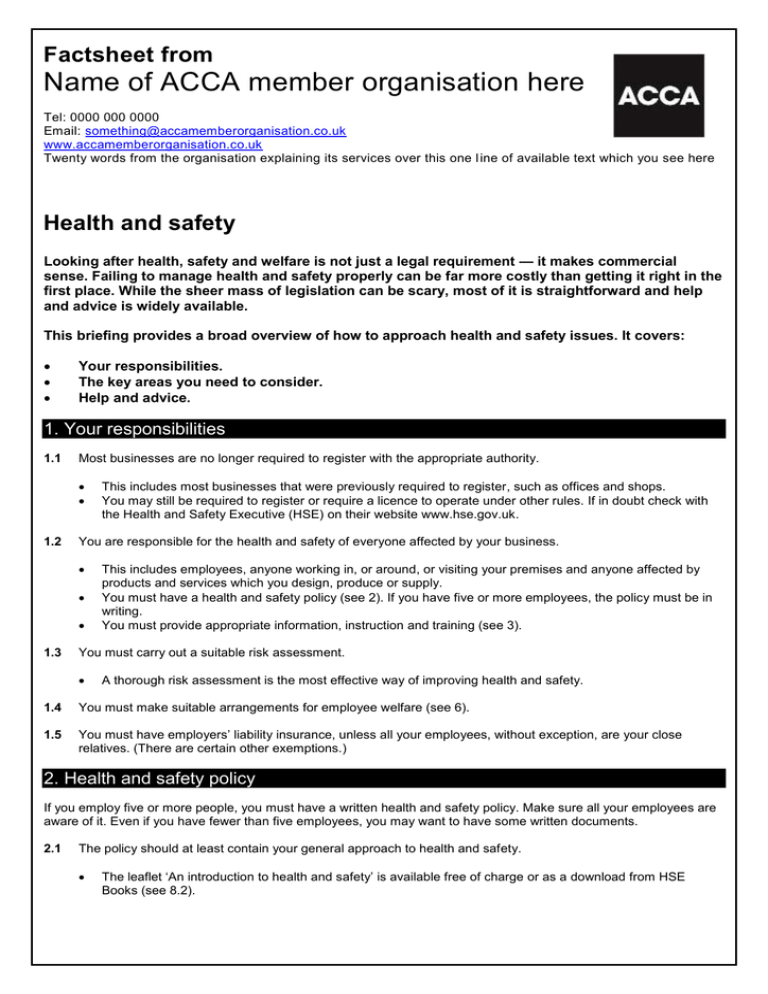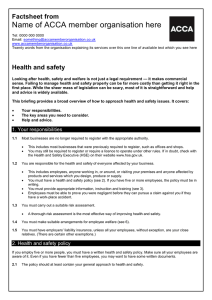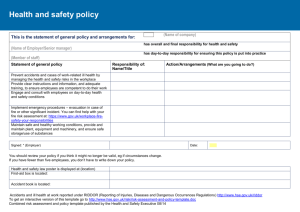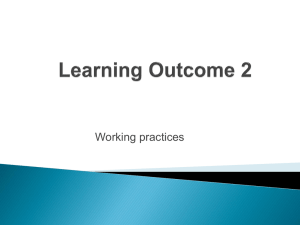
Factsheet from
Name of ACCA member organisation here
Tel: 0000 000 0000
Email: something@accamemberorganisation.co.uk
www.accamemberorganisation.co.uk
Twenty words from the organisation explaining its services over this one l ine of available text which you see here
Health and safety
Looking after health, safety and welfare is not just a legal requirement — it makes commercial
sense. Failing to manage health and safety properly can be far more costly than getting it right in the
first place. While the sheer mass of legislation can be scary, most of it is straightforward and help
and advice is widely available.
This briefing provides a broad overview of how to approach health and safety issues. It covers:
Your responsibilities.
The key areas you need to consider.
Help and advice.
1. Your responsibilities
1.1
Most businesses are no longer required to register with the appropriate authority.
1.2
You are responsible for the health and safety of everyone affected by your business.
1.3
This includes most businesses that were previously required to register, such as offices and shops.
You may still be required to register or require a licence to operate under other rules. If in doubt check with
the Health and Safety Executive (HSE) on their website www.hse.gov.uk.
This includes employees, anyone working in, or around, or visiting your premises and anyone affected by
products and services which you design, produce or supply.
You must have a health and safety policy (see 2). If you have five or more employees, the policy must be in
writing.
You must provide appropriate information, instruction and training (see 3).
You must carry out a suitable risk assessment.
A thorough risk assessment is the most effective way of improving health and safety.
1.4
You must make suitable arrangements for employee welfare (see 6).
1.5
You must have employers’ liability insurance, unless all your employees, without exception, are your close
relatives. (There are certain other exemptions.)
2. Health and safety policy
If you employ five or more people, you must have a written health and safety policy. Make sure all your employees are
aware of it. Even if you have fewer than five employees, you may want to have some written documents.
2.1
The policy should at least contain your general approach to health and safety.
The leaflet ‘An introduction to health and safety’ is available free of charge or as a download from HSE
Books (see 8.2).
2.2
The policy should include how you organise for health and safety.
2.3
Appoint ‘competent persons’ to help with the organisation of health and safety matters (see box).
You may need to use an outside consultancy for help.
The directors of your company still retain final responsibility. They could face civil or criminal legal
proceedings if health and safety failures lead to an accident.
The policy should also include or refer to the specific procedures you have for managing health and safety.
For example, your evacuation procedure in the event of a fire.
3. Personnel
3.1
Provide appropriate health and safety training for all employees.
3.2
Provide health and safety information for all employees.
3.3
You must display the poster ‘Health and safety law: What you should know’ (from £7.66 from HSE Books), or
distribute the leaflet. Copies of the leaflet can be printed from the HSE website (www.hse.gov.uk). A new
version of the poster was introduced in 2009. You can use old versions until April 2014 providing they are
readable and contain up-to-date contacts for the enforcing body and the Employment Medical Advisory
Service.
You must give employees information about risks to their health and safety, and about the preventive
measures that are in place to control risks.
Use appropriate safety signs. For example, for hard hat areas, slippery surfaces etc.
Involve employees in health and safety.
3.4
Include health and safety in induction, particularly for employees who will be placed in hazardous situations,
and when employees are moved to another department or site.
Carry out a risk assessment and provide training whenever new equipment is introduced or working
practices change.
Monitor employee behaviour to ensure that training is effective and that health and safety procedures are
being followed.
Employees have the right to be consulted about issues which affect them.
It may help to set up a safety committee.
Include health and safety in employees’ contracts.
Remind employees that they are legally responsible for their behaviour as it affects the health and safety of
themselves and others. You are also responsible for their behaviour.
Make behaviour which breaches your policy a disciplinary offence.
4. Fire precautions
4.1
The Regulatory Reform (Fire Safety) Order 2005 lays down basic requirements for minimising the risk from fires.
These include:
Escape routes to a place of safety.
Fire-resistant doors and walls.
Firefighting equipment.
Fire alarms.
Emergency lighting.
Safe storage of inflammable and dangerous materials.
Staff training.
2
4.2
You must ensure that your premises meet the standards set by the regulations.
If your building is sub-standard, you may need to make alterations.
If you are planning any alterations to your premises, you must ensure that these do not breach the
regulations.
4.3 If you are planning any changes to your premises, you must make sure that these do not breach the regulations.
4.4
You, or a ‘responsible person’ you appoint, must carry out a fire-risk assessment. If you have five or more
employees, you must keep a written record of your assessments.
Your assessment should include the following five stages:
Identify possible fire hazards.
Identify any people who may be at particular risk.
Evaluate the risks that exist, and take steps to remove or reduce them.
Draw up an emergency plan, and train your staff accordingly.
Review your assessment regularly, particularly if there are any changes that may increase the risks.
Individuals, as well as the 'responsible person', can be charged and prosecuted for failure to meet their responsibilities
under the fire safety order. Conviction can result in a prison term.
For more information on fire-risk assessments, contact the Department for Communities and Local Government (0303
444 0000; www.communities.gov.uk).
5. Hazards
Risk assessment is a key part of health and safety. In addition to the general need to assess hazards, there are
particular regulations to consider.
5.1
You must minimise the risks from work equipment.
5.2
You must ensure that your premises are healthy and safe.
5.3
Special regulations apply to dangerous equipment.
Electrical equipment must be properly inspected and maintained.
Procedures must be in place to make sure that employees do not suffer excessive exposure to VDUs
without rest breaks.
Suitable equipment and training must be provided to avoid unnecessary handling of heavy loads.
When purchasing equipment or machinery, you must satisfy yourself that it is safe.
Workstations should be suitable for the people using them and seating should provide adequate support.
The workplace layout should allow people to move about safely.
The workplace must also provide for employee welfare (see 6).
Under the COSHH (Control of Substances Hazardous to Health) regulations, you must assess and control the
risks from hazardous substances.
In a normal office environment risks are low.
However, some substances such as printer toner can be dangerous and must be appropriately used, labelled and
stored.
6. Employee welfare
6.1
You must provide enough clean, working toilets.
Hot and cold water, soap and towels or a hand dryer must be available.
Mixed facilities are allowed, provided they are enclosed and lockable from the inside.
3
6.2
You must provide mains or bottled drinking water.
6.3
Working areas should be cleaned regularly.
6.4
Waste should be removed and safely stored.
The temperature should be comfortable.
Recommended levels are at least 16º C where people are seated and at least 13º C where people are
active.
If the temperature must be lower, employees should not be exposed for long and they should be given
suitable clothing.
Thermometers should be available.
6.5
Adequate lighting is a requirement for both employee welfare and health and safety.
6.6
The workplace should provide enough space and ventilation.
6.7
Recommendations are that employees should have at least 11 cubic metres per person (not counting space
more than three metres above the floor).
If your windows do not provide sufficient ventilation, a mechanical ventilation system may be required.
You must provide employees with an appropriate rest area, depending on your circumstances.
Employees who do physically demanding work usually need one.
Employees who wear special clothing usually need a changing area. Even in a normal office, there must be a
place to hang and dry wet clothing.
If the workplace is not suitable for eating in, provide an eating area.
Implement a smoking policy. Smoking is banned in all commercial premises and enclosed public places.
Pregnant women and new mothers must be given access to rest facilities.
7. Accidents and emergencies
7.1
You must have suitable first-aid facilities.
The number of first-aid kits and named first aiders you need is a matter for self-assessment.
7.2
The HSE Information Line can provide you with guidance (see 8.2).
Under the RIDDOR (Reporting of Injuries, Diseases and Dangerous Occurrences Regulations) rules, you are
required to report serious injuries, diseases and dangerous incidents.
All businesses must have an accident book that records the date and details of each accident, including the
injured person’s name. To comply with the Data Protection Act, staff must not be able to see other entries
when they input details into the accident book. All accidents, incidents and ‘near misses’ should be recorded.
You must report any accident that causes someone to be off for more than three days to the HSE or the local
authority.
Visit www.hse.gov.uk/riddor for more information or to report an incident.
7.3
You must have appropriate emergency procedures in case of fire or other emergencies.
8. Help and support
8.1
The local authority — normally the Environmental Health Department — is in charge of health and safety for
most premises (eg offices and shops).
4
8.2
The HSE enforces health and safety law for factories (and all other workplaces not covered by the
localauthority).
8.3
HSE Books provides a range of free and paid-for publications (01787 881 165; www.books.hse.gov.uk).
Your trade association can advise you on health and safety issues for your industry.
Independent health and safety consultants, your local chamber of commerce and business support
organisation can also provide useful advice.
Competent persons
If you do not oversee health and safety in your business, you must appoint a competent person to do so.
A.
A competent person will have general managerial abilities.
B.
A competent person will need to be aware of relevant legal requirements and industry standards that exist.
C.
The competent person advises people with authority to implement the health and safety policy.
D.
The person will need to be adequately trained, and it may be appropriate for them to have, or to be working
towards, a suitable qualification.
You can ask for advice on which qualification would be best (see 8).
Special cases
A.
Your health and safety and fire arrangements must take into account any particular difficulties faced by people
with disabilities (employees or visitors).
B.
Special regulations cover the employment of young people (below 18 years of age).
C.
Extra care needs to be taken to avoid exposing pregnant women to situations which could harm either the
woman or the unborn child.
For example, heavy lifting or exposure to harmful substances.
D.
If your business provides food (either to employees or to the public), you will need to register with the
Environmental Health Department.
E.
Businesses with particular dangers face extra regulation, eg the construction industry as well as businesses
involved with chemical processing, mining, explosives and petroleum products.
Note
Health and safety law is complex. This briefing reflects our understanding of the basic legal position as known at the
last update. Obtain legal advice on your own specific circumstances and check whether any relevant rules have
changed.
Note
Consider taking out legal expenses insurance in case you are sued for a breach of health and safety regulations.
Experts’ quotes
“Safety management pays a good return in the long term, so if it’s a good dividend you want for your shareholders,
factor in good safety management and loss control.”
Sypol
5
Expert contributors
Thanks to Sypol, 01296 415715.
Further Help
Last updated 01.02.12
© BHP Information Solutions 2012. ISSN 1369-1996. All rights reserved. No part of this publication may be reproduced or transmitted without the
written permission of the publisher. This publication is for general guidance only. The publisher, expert contributors and distributor disclaim all liability
for any errors or omissions. Consult your local business support organisation or your professional adviser for help and advice.
6






